Welcome to Throwback Reviews, a monthly review about a science book that has been already available to the public, but its impact is still prevalent.
The Phenomena Known as Hallucinations
Hallucinations by Oliver Sacks

The common consensus by many readers is that Oliver Sacks is for Neurology what Carl Sagan is for Cosmology. His impeccable writing and in-depth portrayal of complex neurological phenomena in a simpler depiction bring experts and non-experts together to enjoy the brilliance of the brain.
In his 2012 book, Oliver Sacks explores the phenomena known as hallucinations. This change in perceptions that are not present or seem unreal, are thought to be sporadic and—as some people want to believe—divine. Sacks’ insightful analysis proves that there’s more than what we know about hallucinations.
In typical Oliver Sacks fashion, he displays an array of studies, stories and analyses on hallucinations, from sensory deprivation, disorders, and even religious experiences. Oliver’s superb recounting of history, specifically neurology, brings a timeline of the understanding on how in the previous centuries, hallucinations were presented and defined. Charles Bonnet, William James and even the description of phantom limbs by V.S. Ramachandran are brought to the scene of each chapter to help bring context to each hallucination.
Even Sacks, who previously—in this book also—narrated other people’s experience to present rare neurological disorders, brings himself center page when he explains hallucinations produced by the drug Artane, a drug used to treat Parkinson’s disease:
“I was in the kitchen, putting on a kettle for tea, when I heard a knocking at my front door. It was my friends Jim and Kathy; they would often drop round on a Sunday morning. ‘Come in, the doors open,’ I called out, and as they settled themselves in the living room, I asked, ‘How do you like your eggs?’ Jim liked them sunny side up, he said. Kathy preferred them over easy. We chatted away while I sizzled their ham and eggs–there were low swinging doors between the kitchen and the living room, so we could hear each other easily. Then, five minutes later I shouted, ‘Everything’s ready,’ put their ham and eggs on a tray, walked to the living room–and found it completely empty. No Jim, no Kathy, no sign that they had ever been there. I was so staggered I almost dropped the tray.”
The book is a brilliant journey to the deep phenomenon of hundreds of patients and regular people who experience a moment when reality and hallucinations merge themselves to bring an intriguing and unique experience. Sacks does an amazing job, bringing this weirdness down to the neurological field with a great quantity of literature, covering from the 18th century to the present.
Hallucinations can emerge in disorders like epilepsy, partial or complete blindness, and migraines, among others. But, Sacks also takes it to everyday life, especially while someone is falling to sleep or waking up. You might have heard of the legend of a demon choking you at night while you’re paralyzed gazing at the ceiling. Sacks does an amazing job on describing sleep paralysis and narcolepsy, that might be perceived as something from the supernatural but is actually a hallucination. “The mare in nightmare originally was referred to a demonic woman who suffocated sleepers by lying on their chests.”
Oliver then adds:
“The terror of this state (sleep paralysis) is heightened by the shallow breathing of REM sleep and a rapid or irregular heartbeat, which can go with extreme excitement. Such overpowering fear and its physiological accompaniments can even be fatal, especially if there is a cultural tradition that associates sleep paralysis with death.”
Last Word on Hallucinations
The mind of Oliver Sacks (R.I.P.) was an incredible array of curiousness and obsession of studying on how the brain manifests itself in the everyday moment. This book is perfect to study the mysteries of such effects by the brain. While Sacks usually focuses on rare clinical tales, this imaginative book displays his well-versed abilities in describing the complex processes that make hallucinations into our regular understanding.
Main Image Credit:

